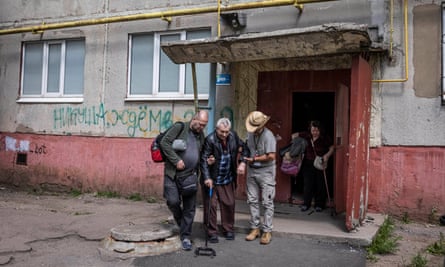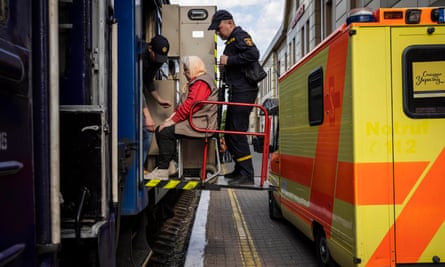It was Nina’s 88th birthday, and she marked it by leaving behind everything she had known. Volunteers, not particularly young or fit themselves, carried her down three flights of stairs from her flat, past the irises about to bloom in her neighbour’s patch of garden.
Apartment buildings hid the ruins of the local school, destroyed last week by a Russian missile, but the war intruded on the yard anyway, the regular thump of distant artillery echoing through the sunny afternoon.
This corner of Donbas is one of the few parts of Ukraine still threatened by an advancing army, and fear has largely emptied the town of Konstiantynivka of its families.
Defeated in Kyiv, pushed back from Kharkiv, Moscow has thrown its anger and many extra troops into long stretches of the eastern front.
Targets are pulverised by artillery and airstrikes, then Russian soldiers move forward a few miles and declare the “liberation” of places such as Popasna – more ruin than town when it was captured, survivors say.
“There is no Popasna now,” said Oleh, a construction worker who had tried to ride out the fighting in a basement shelter with his family until their own home was hit. “Even when you look at photos and videos, your brain can’t understand what you are seeing. It’s hard to know that this is where you lived.”
Residents of places that might be next have been urged by government and relatives to leave while it is still possible, advice that many heeded weeks ago. Driving through the region is a journey through ghost towns, with empty streets of shuttered shops, deserted homes and abandoned parks.
An eerie quiet interrupted only by air raid sirens or explosions hangs over these half-abandoned communities – from Bakhmut, the last major Ukrainian-held outpost before the frontline at Popasna, west to Kramatorsk, site of a bloody attack on civilians waiting for an evacuation train, or south through Druzhkivka to Konstiantynivka.

Only the hospital trauma wards are bustling, filled with the terrible shrapnel wounds of a war waged mostly by rocket and artillery, bringing severed limbs and lacerated bodies.
Those who gambled on staying – hoping the Russians won’t arrive or their homes won’t be hit – are mostly the old, the sick and the poor, who can’t physically leave, fear they can’t afford to live somewhere else, or simply can’t face starting again somewhere new so late in life.
“I’m too old for this,” said Oleksandr, 67, his face crumpling into tears as he waited to be driven away from his home of 33 years, with his wife, Tanya, 64. He is a stroke survivor who can barely walk, and his daughter had badgered the couple into accepting an evacuation offer from Druzhkivka before they become trapped there by a rain of Russian shells.
“I’m a little scared,” Tanya admitted. “We’ve been hearing heavy bombing for a week now, there was one last night.” As she waved goodbye to a few hold-out neighbours, all retirees like themselves, one woman in sandals asked how she could get on the list for a ride.
Like so much of the civilian response to the Russian invasion, this evacuation is an unlikely and improvised effort run by volunteers willing to risk their lives for strangers. They help those who are too ill to leave in ordinary cars, or can’t afford to pay for their own travel, or are daunted by the logistics of fleeing across a country at war.
Vlad is driving the lead car, finding addresses given to him by a local Ukrainian charity, Vostok SOS, and reassuring the evacuees. Mark Poppert, an American who has left his home in Doha to volunteer with the UK-based charity, Refugease, is at the wheel of a van that serves as a rudimentary ambulance for evacuees who can’t sit up. They have already called at Druzhkivka to collect Oleksandr and Tanya; now the makeshift convoy has arrived in Konstiantynivka.
Poppert wears a Stetson as a nod to his Nebraskan roots. “So the Ukrainians know they have international support,” he says, although it is unclear how many locals pick up on the gesture of solidarity. The two men use Google Translate to communicate, because they have no shared language to manage their urgent shared mission.
Russian bombs are not the only threat residents of these small towns are trying to balance. The pressures of war have thrown daily life into chaos and made people vulnerable in other ways. Nina and her daughter Irena, 60, were both being treated for cancer at Kramatorsk hospital, but with the Russian advance their doctors left and the oncology ward was shuttered. Nina’s grandson Anatoly, 43, is disabled and Irena is clearly frantic with worry about what the interruption to her treatment could mean for him.

“We had no relatives to help us organise healthcare,” said Irena. “My mother is paralysed and can’t talk, but we couldn’t even get any painkillers. We are going to Dnipro now: someone said they will help us get into hospital there.”
After Nina is carried down the stairs by their rescuers, she is laid carefully on a bedding roll spread on the floor of Mark’s van, her head protected by pillows, for the two-hour drive to a special evacuation train leaving from Pokrovsk.
Signs in the windows read “invalids”, more for the railway guards than for Russian attackers. When the convoy arrives, everyone on the platform is slightly nervous, after last month’s strike on nearby Kramatorsk station.
For many of those climbing on board, this escape from immediate danger will be the most painful but straightforward step in a long and difficult journey towards some kind of new life.
Also in Vlad’s car are Irina, five months pregnant, and her nine-year-old daughter Amina. “I was afraid to be alone with a child on the way, they said the town was being encircled and we should leave,” said Irina, after making a final reading of the gas meter and handing the key of her rented flat over to her landlady.
She leaves behind an aunt who is like a mother to her, a job at a local gas company, and – like all the others who are going – the only place she has ever called home. Pregnant and with a child, she is striking out into the unknown with little more than a phone number of a friend in Poland.
“She said we could stay, I’ll call her when I get near Warsaw and she will give me the exact address,” she said. Charities have been warning about the trafficking of women like Irina, vulnerable and alone, as they cross into Europe.

The risks of this journey into the unknown is one reason some stay near the frontline. “We have relatives in the west, but we don’t have any job. How will we support ourselves when we get there?” said Oleh, who drove his wife, son, daughter-in-law, two granddaughters and their cat through heavy shelling to Bakhmut.
After the intense battle for Popasna, the ghost towns of Donetsk seem like something of a haven, and they have free beds in a shelter, so they plan to stay in Bakhmut for now, despite a steady increase in shelling.
“One recent hit was on a student dormitory. Children had been playing there half an hour before, but fortunately they had just left,” said Bakhmut deputy mayor Maksym Sutkovyi. He estimates that at least a third of the town’s prewar population of about 100,000 have stayed, a number swelled by people escaping from fighting to the east.
“Of course I’m worried: we understand that the war in its next phase can come here,” he said, but he plans to stay, along with the rest of the town council. “Those who stay need basic living conditions, and we have to maintain critical infrastructure … people will better support our army and country if we are here.”
